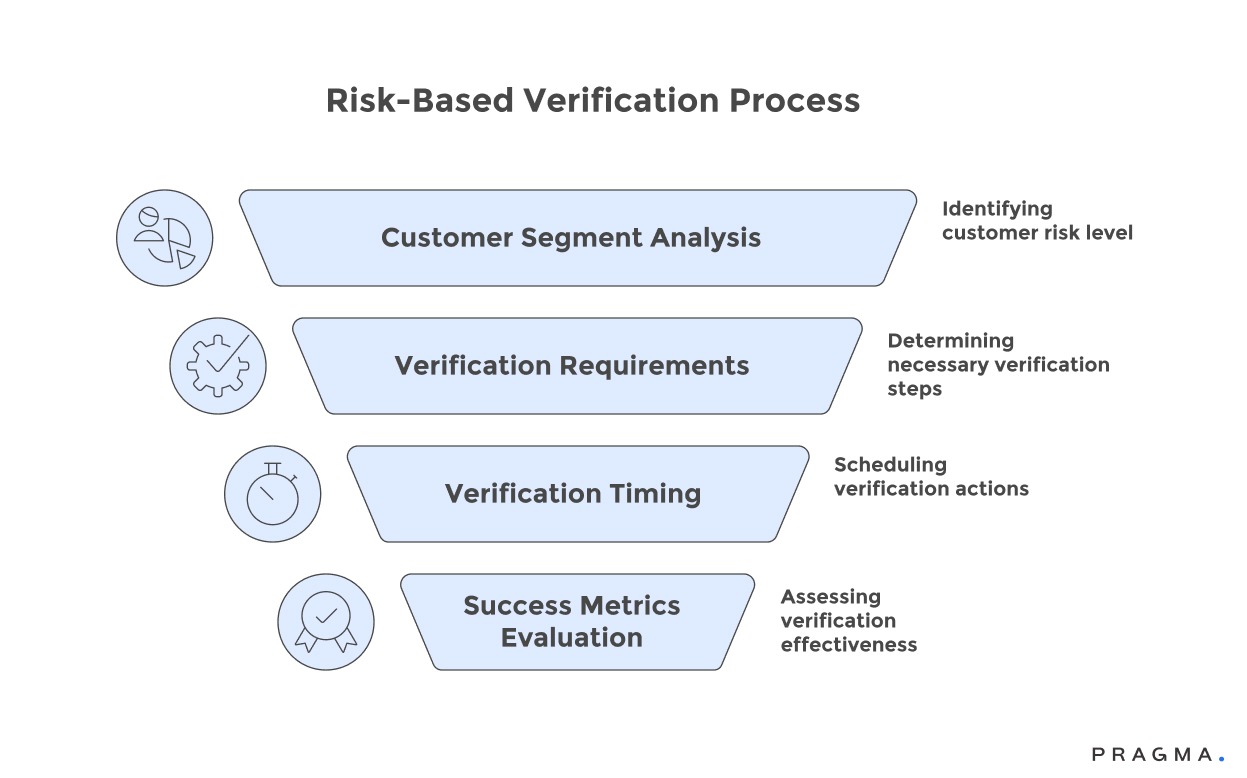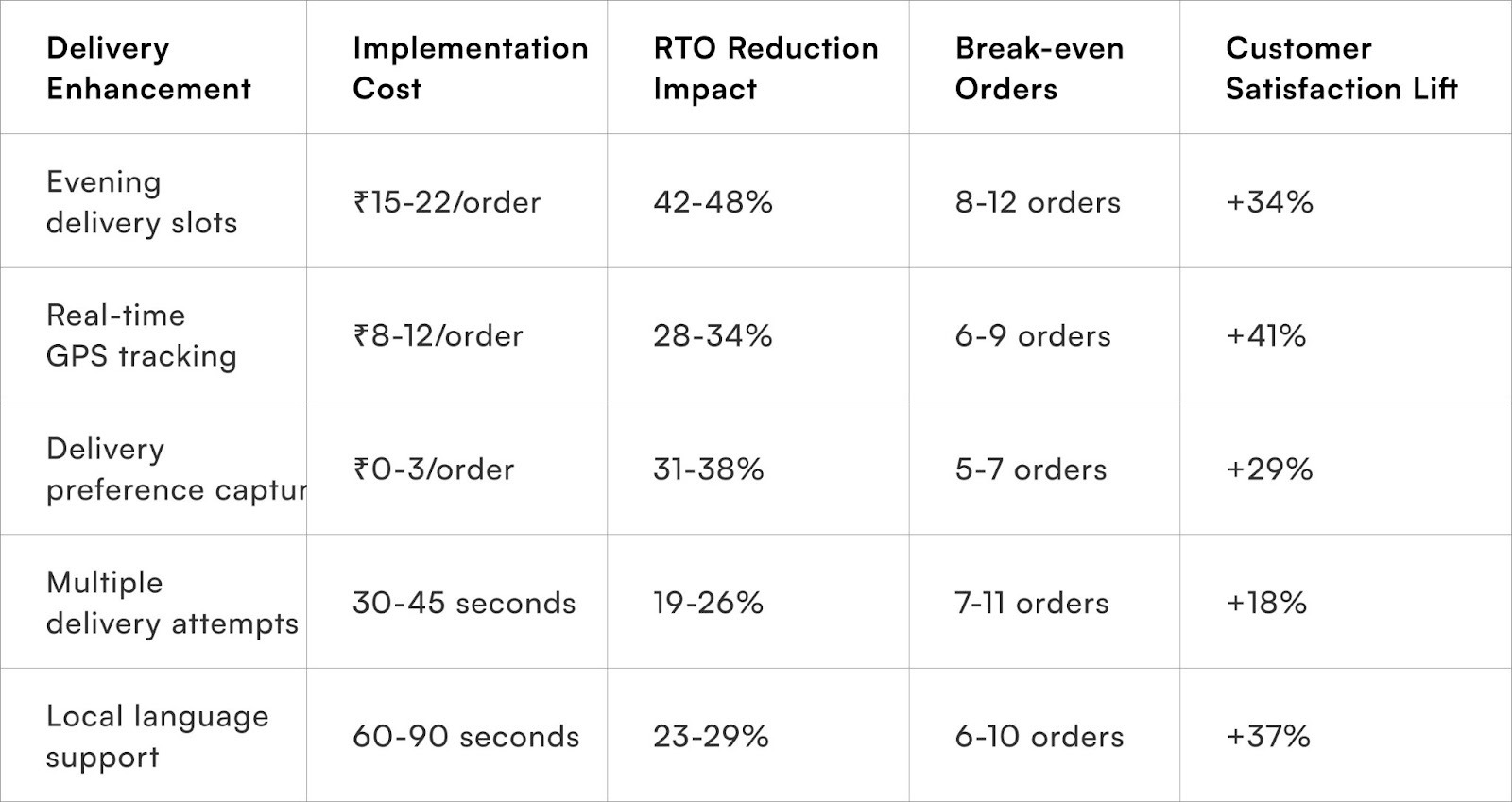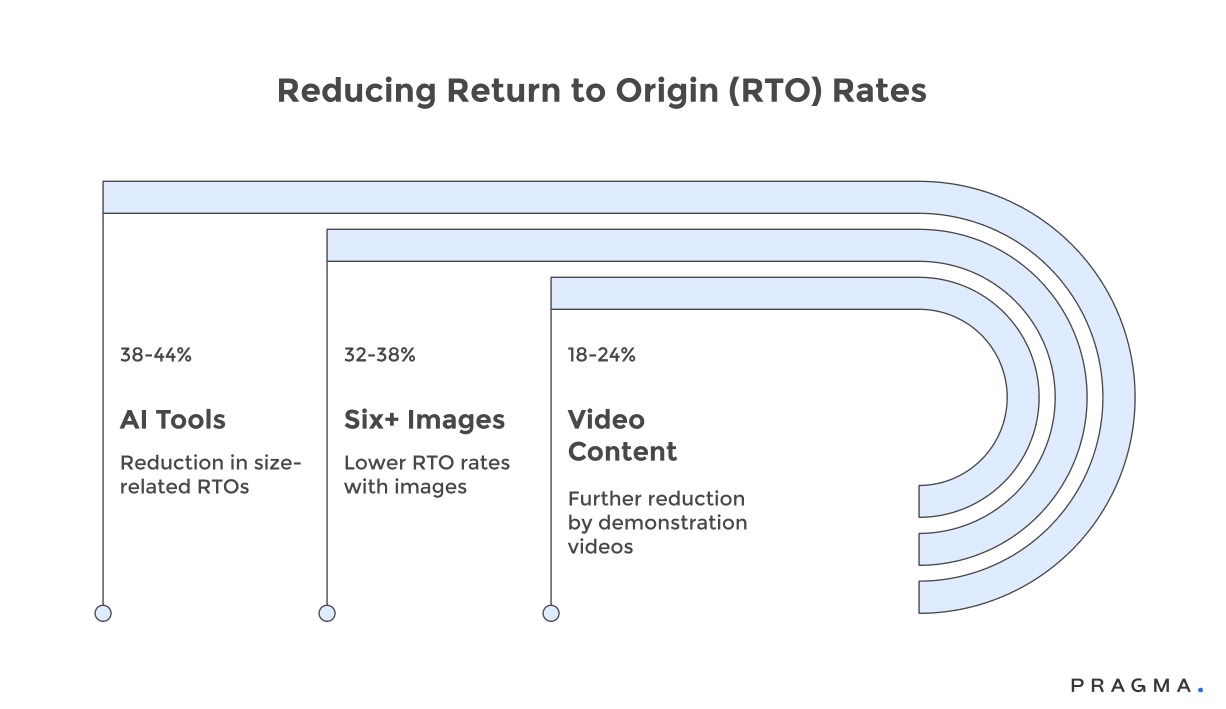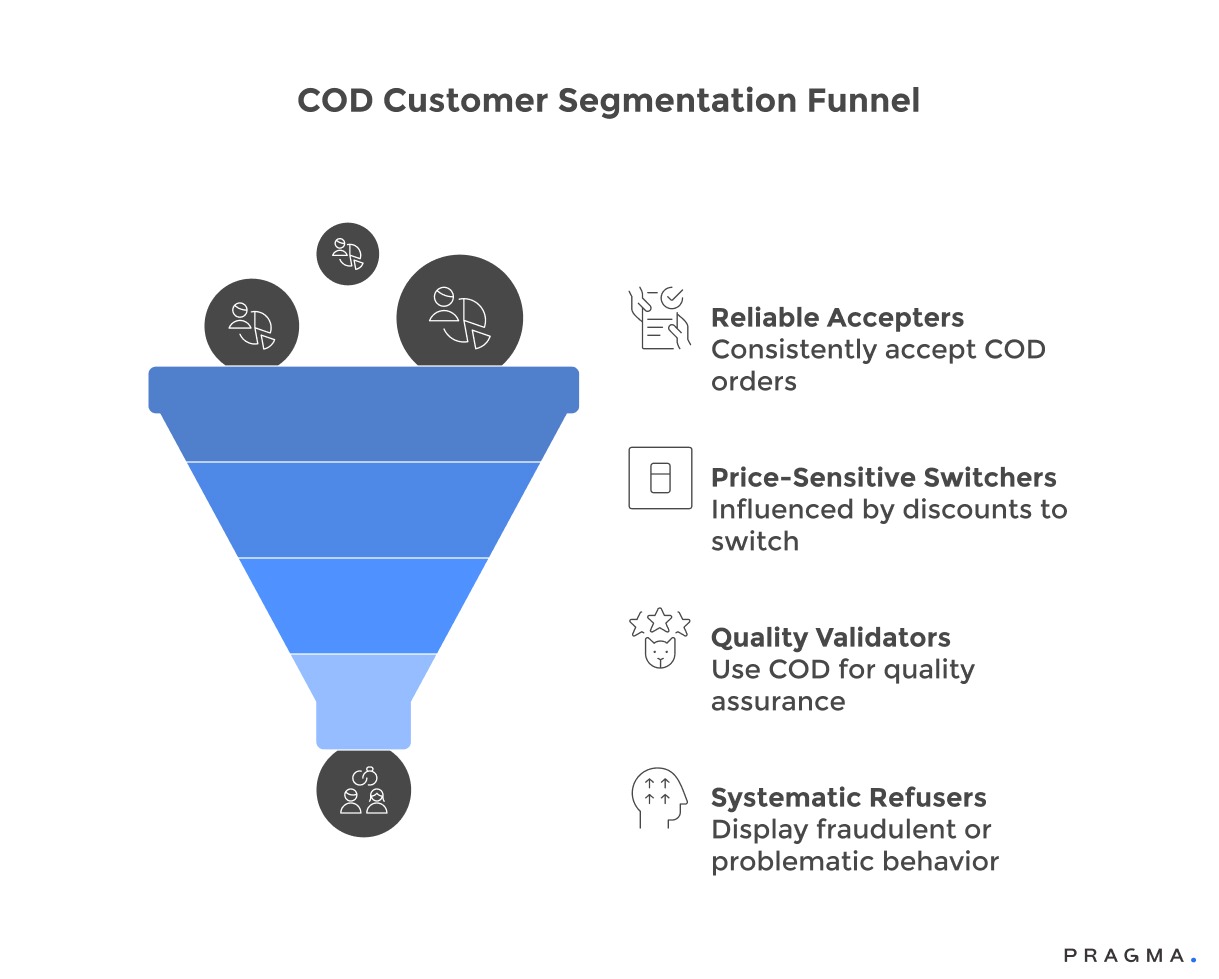Your conversion rate climbs as you expand COD availability across new pin codes. Then the returns start flooding in. Orders marked "customer refused" pile up from areas showing strong purchase intent. Your logistics costs balloon whilst inventory sits in reverse transit instead of reaching actual customers.
The classic e-commerce trap: choosing between growth and profitability.
Industry data from 142 Indian D2C brands tracked through 2024 shows that COD represents 58-64% of orders in Tier-2 and Tier-3 markets, yet contributes to 76-83% of total RTO volume. Average RTO rates hover at 28-35% for COD transactions compared to 4-8% for prepaid orders. Each returned COD order costs brands ₹180-240 in forward shipping, reverse logistics, and processing overhead whilst generating zero revenue. Brands processing 10,000 monthly COD orders lose ₹5.8-7.2 lakhs to RTO-related expenses before counting opportunity costs.
In this comprehensive guide on how to reduce RTO in Indian e-commerce without hurting COD orders, we're exploring systematic approaches that preserve payment flexibility whilst eliminating preventable returns. Brands implementing balanced RTO reduction strategies report 42-48% decrease in return rates, 89% retention of COD conversion volumes, and ₹3.2-4.1 improvement in contribution margin per order within 90-120 days of deployment.
Why does restricting COD availability backfire for most brands?
Blanket payment restrictions sacrifice addressable market without solving underlying behavioural issues
The immediate reaction to rising RTO rates involves limiting COD to "safe" customers or geographies, but this approach eliminates entire market segments without addressing why returns happen. Analysis of 34,000 RTO cases across fashion, beauty, and home categories reveals that 67% of returns stem from
- delivery logistics failures
- inadequate product information
- or sizing uncertainties rather than payment fraud or wilful refusal.
Geographic restrictions prove particularly damaging because pin code-level RTO rates mask significant within-area variation.
A Tier-2 city showing 38% overall RTO might contain neighbourhoods with 12% return rates alongside areas hitting 61%. Blanket COD removal punishes high-intent customers sharing postal codes with problematic addresses. Brands lose ₹12-15 in lifetime value for every legitimate customer rejected through crude filtering.
Payment method migration attempts often compound problems rather than solving them. Forcing customers toward prepaid options without addressing their underlying COD preference reasons—limited digital payment trust, budget uncertainty, product quality concerns—simply shifts them to competitor websites offering familiar payment flexibility. Customer acquisition costs of ₹450-680 make losing prospects over payment restrictions an expensive way to avoid ₹180-240 RTO expenses.
What verification methods preserve conversion whilst filtering risk?
Intelligent confirmation workflows balance friction with fraud prevention through contextual application
Effective verification operates on segmented risk thresholds rather than universal requirements. First-time buyers ordering above ₹2,500 face different validation than repeat customers with successful delivery history. The key lies in matching verification intensity to actual risk profiles derived from behavioural data rather than demographic assumptions.
Phone verification through OTP systems provides lightweight confirmation for medium-risk scenarios. When customers complete phone validation, RTO rates drop 34-41% compared to unverified orders without adding significant conversion friction.
The critical implementation detail involves timing:
requesting verification immediately after order placement maintains momentum, whilst delayed verification attempts see 23-28% lower completion rates as purchase intent fades.
Address confirmation through SMS or WhatsApp before dispatch catches incomplete or incorrect details that cause 18-24% of total RTOs. Smart implementation involves sending customers their full delivery address with a simple "Reply YES to confirm or send corrections" prompt. This two-way validation identifies issues like missing flat numbers, incorrect landmarks, or outdated contact details that courier partners would otherwise encounter during failed delivery attempts.

How can delivery experience improvements reduce refusal rates?
Logistics optimisation addresses the largest RTO driver that payment restrictions completely ignore
Courier partner performance accounts for 31-37% of COD returns according to detailed NDR analysis across 50+ D2C brands. Delivery attempts during working hours when customers are unavailable, inadequate delivery notifications, poor courier behaviour, and inflexible rescheduling options create legitimate refusal scenarios that have nothing to do with payment method or customer intent.
Time slot preferences transform delivery success rates in urban markets. Customers offered evening delivery windows between 6-9 PM show 47-53% lower RTO rates compared to standard daytime delivery. Implementation requires courier partner coordination and inventory planning adjustments, but the economics remain compelling: spending ₹15-20 extra for evening delivery costs far less than ₹180-240 RTO expenses.
Delivery tracking transparency reduces anxiety-driven refusals. Real-time SMS updates at dispatch, in-transit, out-for-delivery, and nearby stages keep customers informed and prepared. Brands providing accurate 30-minute delivery windows through GPS tracking see 28-34% fewer "customer unavailable" scenarios. The psychological shift from "package arriving sometime today" to "delivery in 25 minutes" dramatically improves reception readiness.

Why does pre-purchase education prevent post-delivery surprises?
Information asymmetry drives quality expectation mismatches that manifest as delivery refusals
Bridging the Expectation-Reality Gap to Reduce RTO in Indian E-commerce
A significant contributor to Return to Origin (RTO) in Indian e-commerce, particularly for Cash on Delivery (COD) orders, stems from the disconnect between customer expectations and the actual product received. This often leads to doorstep refusals rather than formal returns, highlighting issues in product presentation.
Key areas for improvement include:
- Inadequate Product Information:
- Size Guides: Insufficient or inaccurate size guides are responsible for 41-48% of fashion-related RTOs.
- Product Imagery: Poor quality or limited product imagery accounts for 23-29% of returns in the beauty and personal care categories.
These information gaps occur during the browsing phase but result in costly refusals at the time of delivery.
Strategies for RTO Reduction:

- Leveraging Technology for Pre-Purchase Clarity:
- AI-Powered Size Recommendation Tools: Brands implementing AI tools that offer fit suggestions based on customer measurements, purchase history, and crowd-sourced data have reported a 38-44% reduction in size-related RTOs. These tools empower customers to make informed decisions before purchase, mitigating logistics costs associated with returns.
- Enhancing Visual Content:
- Comprehensive Imagery: Products featuring six or more images, including detailed shots, lifestyle context, scale references, and usage demonstrations, show 32-38% lower RTO rates compared to listings with only 2-3 standard product images.
- Video Content: Incorporating 60-90 second demonstration videos can further reduce returns by an additional 18-24% by setting realistic customer expectations.
- Building Trust Through Authenticity:
- Verified Customer Reviews: Authentic reviews from verified purchasers, especially those with customer-submitted photos, effectively reduce information asymmetry more than brand-generated content. Customers who view eight or more authentic reviews before purchase demonstrate a 29-35% lower RTO propensity, as social proof instills confidence and replaces individual uncertainty with crowd-validated quality expectations.
What incentive structures encourage COD acceptance without margin erosion?
Behavioural nudges shift payment preferences through value perception rather than forced restrictions
Effective Strategies to Incentivise Prepaid Orders and Reduce RTO in Indian E-commerce
To mitigate Return to Origin (RTO) in Indian e-commerce without negatively impacting Cash on Delivery (COD) orders, businesses can implement several effective strategies to encourage prepaid payments. These approaches focus on psychological impact, loss aversion, and long-term loyalty.
1. Strategic Prepaid Discounts:
While prepaid discounts are a common incentive, their effectiveness lies in the details of implementation. Absolute discounts tend to have a stronger psychological impact than percentage-based savings, even with similar margin implications. For instance,
a flat ₹50 discount on an ₹800 order is more effective
than a 5-8% percentage discount on higher values.
Research shows that ₹50-100 absolute discounts can convert 31-38% of COD-preferring customers to prepaid, whereas percentage discounts achieve only 18-23% conversion.
2. Free Shipping Thresholds Linked to Prepaid Selection:
Leveraging loss aversion psychology, businesses can tie free shipping eligibility to prepaid order selection. Customers who are within ₹150-250 of reaching a free shipping threshold are 42-47% more likely to convert to prepaid
if the messaging emphasises "switch to prepaid to unlock free delivery." This narrative reframes the situation from a restriction (COD charges) to an opportunity to gain, driving behavioral change without creating adversarial dynamics with customers.
3. Loyalty Program Acceleration for Prepaid Orders:
To foster long-term payment preference migration, accelerate loyalty program rewards for prepaid purchases. Offering double reward points on prepaid orders creates a sustained incentive beyond one-time discounts. Customers who accumulate rewards faster through prepaid transactions are more likely to develop habitual prepaid payment preferences. Data indicates that 64-71% of customers maintain their prepaid selection in subsequent orders after an initial incentive-driven switch.
How does customer segmentation enable targeted RTO reduction?
Behavioural clustering identifies distinct groups requiring different intervention strategies
To effectively reduce Return to Origin (RTO) rates in Indian e-commerce, it's crucial to move beyond basic demographics and segment customers based on predictive behavioral patterns. An analysis of 67,000 customer profiles from Indian D2C brands reveals five distinct segments, each with unique RTO drivers and requiring tailored prevention strategies:

- Reliable Accepters:
This group, comprising 35-42% of COD users, consistently accepts their Cash on Delivery (COD) orders across various values and categories. For these customers, minimal intervention is needed. Focusing on swift conversion and convenience is key, as over-verification only creates unnecessary friction without significantly reducing RTO.
- Price-Sensitive Switchers:
These customers are influenced by incentives, toggling between COD and prepaid options. They respond strongly to targeted discounts; for instance, 68-74% choose prepaid when offered ₹75-125 discounts at checkout. With moderate RTO rates of 15-22% on their COD orders, a gentle approach to encourage prepaid migration is more economical than aggressive COD restrictions.
- Quality Validators:
Using COD as a safeguard against product disappointment, this segment exhibits high RTO rates (48-54%) due to active quality checking. To address their underlying trust issues, brands should provide enhanced pre-purchase information, flexible exchange policies, and robust quality guarantees. Restricting COD for this group often leads them to competitors, whereas improved product presentation can reduce their returns by 41-48%.
- Systematic Refusers:
This segment, representing 4-7% of COD customers, displays problematic patterns such as multiple addresses, immediate refusal of high-value orders, or coordinated fraud. Strict measures are warranted for this group, including COD restrictions, manual verification, and account monitoring. Accurate identification is paramount to avoid unfairly penalising legitimate customers.

To Wrap It Up
RTO reduction succeeds when approached as system optimisation rather than customer restriction. The brands achieving sustainable improvements combine intelligent verification with delivery experience enhancements and behavioural incentives that preserve market access whilst eliminating preventable returns.
Analyse your top 50 RTO cases this week to identify which prevention category each falls into: verification gaps, delivery failures, or information mismatches, then deploy targeted solutions for your highest-volume category.
Sustained RTO management requires continuous refinement as customer behaviour evolves, new markets open, and competitive dynamics shift payment preferences. Brands treating RTO reduction as ongoing operational discipline rather than one-time project achieve 18-24% additional improvement in year two through systematic learning, courier partner optimisation, and customer behaviour pattern recognition that compounds over time.
For D2C brands seeking to balance COD availability with operational efficiency, Pragma's intelligent order management system provides real-time risk scoring, automated verification workflows, and delivery optimisation tools that help brands achieve 40-48% RTO reduction whilst maintaining 89-95% of COD conversion volume and improving contribution margins by ₹3.2-4.1 per order.

FAQs (Frequently Asked Questions on How to Reduce RTO in Indian E-commerce Without Hurting COD Orders)
1. Should I completely turn off COD to reduce RTO?
No—removing COD can cripple new customer acquisition, especially in India, where 58–65% of first-time buyers use it for trust reasons. Instead, restrict COD for repeat RTO offenders, use risk-based pincodes, and offer incentives for prepaid orders so you reduce RTO without killing conversions.
2. Do address and phone verification actually reduce returns?
Yes—address auto-complete, PIN validation, and mandatory phone fields cut failed deliveries significantly. Adding WhatsApp or IVR order confirmation for COD orders reduces fake orders and accidental purchases, helping brands see RTO drop by 10–25% within weeks.
3. Is it worth using multiple couriers or blocking entire pincodes?
It can be—switching to couriers with better reach in high-RTO regions, or blocking COD in chronic offender pincodes, prevents repeat losses. Use delivery data and NDRs to actively monitor and update your “high-risk zone” list monthly.
4. How do partial COD or upfront token payments affect RTO and conversions?
Collecting a small amount upfront (₹49–₹199) for COD increases delivery intent and can nearly halve RTOs in risky regions. Some drop-off in overall COD orders does occur, but overall revenue and delivery rates improve since these “token” buyers are less likely to refuse parcels
Talk to our experts for a customised solution that can maximise your sales funnel
Book a demo




.png)